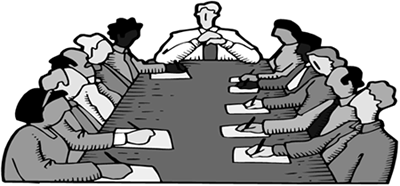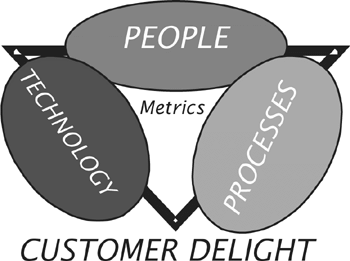by John Moran and Lee Weimer, Community of Practice Facilitators
So, you've read through all the chapters of this book and assimilated lots of good information. What's next? How do you continue the learning process? Where do you go to get even more information? How do you keep current with changes and best practices in the industry?
John Moran and Lee Weimer describe a powerful approach to these challenges: Become an active member of a Community of Practice (CoP).
Imagine meeting regularly with a small group of other CIOs who are facing issues and problems similar to yours. Some of the CIOs are ahead of you in certain project implementations, while others are taking a totally different approach to problem resolution.
These are regular, informal meetings at which you select the subjects that are on your hot list, and the presenters are qualified to bring in new information on your chosen subject. The different experiences, backgrounds, thought processes, and new information produced during the face-to-face meetings can dramatically increase your professional knowledge and growth. This is the general concept of a Community of Practice.
Communities of Practice (CoP) can be defined as:
A group of people who are brought together by a desire to learn more about a common class of problems, opportunities, and their possible solutions.
Community members accelerate business results and add value by collaborating. Everyone learns from one another and from outside resources.
Members find themselves drawn to one another by a force that is both professional and social. Both of these aspects are key to the success of a CoP. The idea of “professional practice” is critical, because the group's members concentrate on the learning that emerges through “real work” within their organizations. Learning is also social, since the CoP is based on familiarity and reciprocal trust. Thus, CoPs assist both in finding and sharing best practices and in building social capital across organizations.
How can a CoP impact business results? Knowledge management practitioners have recently been investigating the importance of less structured, or tacit, knowledge as well as the role played by social networks in innovation and knowledge creation. CoPs are seen by many as providing an environment in which this tacit knowledge can be developed, nurtured, and sustained. For example, the CIOs who authored this book are members of a CoP, and they are sharing their best practices (tacit knowledge) with you.
CoPs can exist within a single organization or within a single discipline and can span several organizations. Because CoPs generate extraordinary learning, they are among the most important structures for organizations in which thinking matters. CoPs contribute directly to an organization's intellectual and social capital. A single idea generated from interaction within a CoP might result in a whole new product line, or in saving millions of dollars through shorter implementation of a major IT project, or in better hiring practices. For example, this CIO CoP has begun the process of defining best practices for contract terms for purchasing software that will directly benefit both buyers and sellers.
We've looked at CoPs as individual learning laboratories and seen how CoPs can contribute to the intellectual, financial, and social capital within a business. So, what does one look like, and how does it operate? As examples, we describe two different IT-focused CoPs that we currently facilitate.
This CIO CoP was organized late in 1997 as a fee-facilitated community of CIOs. Its first formal meeting was held in February 1998. CoPs are typically small groups of people that learn together. This CoP is unusual because the members were CIOs from several different companies who wanted to set their own goals and choose the topics that interested them. The participants set their own ground rules and decided who could participate and when they would meet. The topics they wanted to cover would encompass all of a CIO's roles and responsibilities, including:
• People: Coaching and developing the capacity of the IT staff and creating a vivid picture of an ambitious future for the IT organization. Building partnerships with executive management and internal or external customers provides the IT organization with recognition as a proactive contributor to business development.
• Technology: Selecting and utilizing appropriate technologies to keep the organization connected to its stakeholders and to directly benefit the overall business enterprise.
• Processes: Building effective and efficient processes that deliver information to the business enterprise and facilitate its use for strategic and tactical advantage.
• Metrics: Setting the criteria and measuring progress to tell us how we'll know we've been successful.
Over the last few years, the CIO CoP has grown and changed significantly. We now have CIOs from over 20 companies participating; the meetings are one-half day each month and are hosted by a member company. Almost all of our meetings include at least two “expert presenters” who interactively lead the community members in topic discussions. Following this session is another important part of each meeting: a dinner that supports both professional and social interaction. We provide a summary of each meeting with the accompanying presentation material, forming a reference library for the CoP members. Table 17-1 lists a few of the topics we have covered in the past.
In addition to our regular meetings, the members have collaborated in writing this book, developed some best practices in software licensing contracts, and initiated the IT Applications/Operations CoP for their direct reports.
The Silicon Valley Applications/Operations CoP (A/O CoP) started in mid-2001 and is structured much like the CIO CoP. The members include up to two director-level IT people from each company. They meet for a half day plus dinner every other month. The members of this CoP are slowly building the level of trust and familiarity required to begin innovative knowledge sharing. One example of this was a meeting set up by one of the members to learn more from Cisco Systems about the role of IT in mergers and acquisitions. Although this wasn't an official CoP event, the organizer felt secure enough in the CoP members that all were invited to participate in the meeting.
CoPs provide value-added benefits. Our experiences with the Silicon Valley CoPs and discussions with members and presenters have provided insight into the value that the different groups have received from their participation in our CoPs. The following is a summary of those benefits:
Open, interactive discussion. The Silicon Valley CIO CoP and the A/O CoP settings are business casual, and membership is limited (usually under 25) to facilitate ease of interaction and help build close relationships. The meetings are based on a dialogue model, with discussion of a single IT-common topic and an emphasis on interactive questioning and listening as opposed to debate. Since the objective of the CoP is to facilitate growth and learning, there is less need to be right than there is to be open. This does not mean all of the members always agree with one another or with the presenters. There is plenty of convincing attempted among various members, among members and presenters, and among the presenters themselves. But, however spirited the exchanges may get, they are always good-natured.
Trusted network. Close relationships are critically important to the ongoing success of a CoP for both members and facilitators. People are more likely to trust the experiences of those they have come to know over time and with whom they have also shared experiences. The dinner portion of our meetings provides participants with the opportunity to become storytellers, assume roles other than CIO or director, and eventually become friends.
Learning opportunities. By sharing best practices and the experiences of others, members are exposed to a range of new and known products, solutions, and services. They may obtain professional opportunities for themselves or their companies, recognition from their peers, or leads for their next new hire (though active recruitment is not encouraged). The members invariably expand their professional circles, grow, learn, and have fun.
Ongoing communication and reference. Outside of monthly meetings, all communication between members, facilitators, and presenters occurs through email, telephone, or an online forum provided by a sponsoring organization. Responsive communications, quality of speakers and facilitation, and attention to detail all contribute to a complete CoP service.
Target audience. Representatives of companies that have something to offer an IT organization are provided with a rare experience: an opportunity to sit down with members of their top target audience in an informal setting. They must demonstrate their knowledge of the CIOs' problem areas and how their companies and products might help to solve those problems. This is no “hard sell” environment, but an opportunity to demonstrate competence. Through the product or problem knowledge displayed, a vendor can create a relationship with members that the members will want to follow-up.
Learning and business intelligence. Presenters often have an opportunity to learn about competitors' products and services, business areas they are unfamiliar with, and opportunities for their own CIOs or directors.
Learning and close relationships. Facilitators can guide the learning through the presenters they invite, the questions raised during meetings, and the topics they suggest for members' consideration. Facilitators have an opportunity to grow and learn with the members and to make friends and have fun.
Meaningful occupation. Facilitators have the opportunity to provide a needed and appreciated service for a fee.
We've presented a picture of the business and personal benefits you can obtain through participation in a Community of Practice. Your next step is to investigate the possibilities of belonging to a CIO CoP in your area. If you can't locate one, consider building a CoP by profession or common interest. This can be done in almost any geographic area.
As facilitators, we have started building a web of CoPs in various areas. We expect to link the individual affiliate CoPs through the Internet in ways that will permit a broad sharing of information across geographic regions. Please join us.



